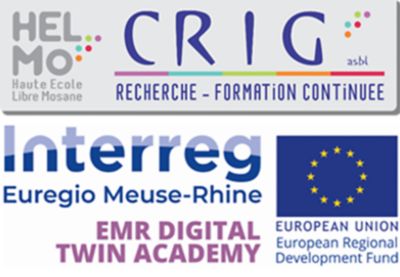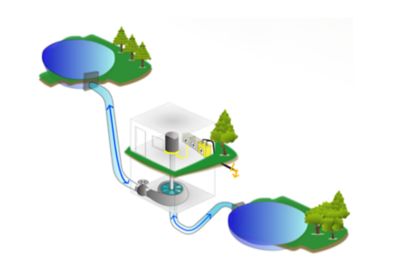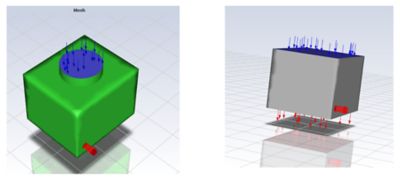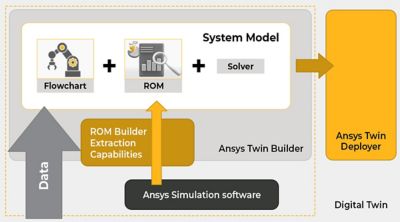-
-
Access Free Student Software
Ansys empowers the next generation of engineers
Students get free access to world-class simulation software.
-
Connect with Ansys Now!
Design your future
Connect with Ansys to explore how simulation can power your next breakthrough.
Countries & Regions
Free Trials
Products & Services
Learn
About
Back
Products & Services
Back
Learn
Ansys empowers the next generation of engineers
Students get free access to world-class simulation software.
Back
About
Design your future
Connect with Ansys to explore how simulation can power your next breakthrough.
Free Trials

Engineering professionals and researchers in Belgium are gaining hands-on experience with key technologies of the fourth and fifth industrial revolutions. The longstanding HELMo Gramme Institute and its research center HELMo Link, formerly known as CRIG, are participating in the Interreg Euregio Meuse-Rhine (EMR) Digital Twin Academy project. Interreg EMR projects are supported by the European Regional Development Fund. The project aims to train professionals and researchers in leading-edge technologies for industry with a focus on digital twins. According to the Digital Twin Consortium, digital twins are virtual representations of real-world entities and processes synchronized at a specified frequency and fidelity.
With the support of Infinite Simulation Systems, an Ansys Elite Channel Partner, and the Ansys Academic Program, project participants integrated Ansys multiphysics simulation and digital twin solutions to explore real-world industry challenges. As a result, they gained firsthand simulation experience while discovering the value of digital twin technology.

Considering Digital Twins for Industrial Applications
Participants completed use cases in collaboration with Belgian industrials, including a company that specializes in the design and integration of plant maintenance and multitechnical services like water loop treatment for industrial refrigeration and district energy networks.
This study aimed to explore using digital twin technology to predict the operating conditions of a water loop cycle in accordance with external factors such as ambient temperature. Project teams would need to model water loop elements, including a heat exchanger. They would also need to review the data history of system operating conditions at different ambient temperatures.
The second case involved a different company that manages the production and distribution of drinking water for local municipalities.
This study sought to model a water distribution network between two reservoirs that must balance each other according to their levels while considering hourly energy costs. To explore this scenario, participants would study a drinking water distribution model consisting of two tanks, valves, sensors, pumps, and pipes.
Aside from the thermal aspects of the second case, project participants discovered that the systems of both cases were similar. Consequently, they could take the same approach, using the same tools in both studies.

This diagram illustrates a water distribution network positioned between two reservoirs for the analysis of an industrial use case.
“Ansys specializes in numerical simulation using finite elements,” says Sarah Nyssen, a research coordinator and assistant professor at HELMo Gramme Institute. “It covers all the stages required for numerical finite element simulation: geometric processing, meshing, resolution, results processing, and optimization. The software offered is useful in a wide range of industrial fields, including mechanical engineering, energy, automotive, rail, aerospace, medical, electronics, and others.”
Applying Simulation and Digital Twins to Industry Use Cases
HELMo project participants used the Ansys Workbench simulation integration platform, which made it easier to manage several tools simultaneously, including Ansys Fluent fluid simulation software and the Ansys Twin Builder simulation-based digital twin platform.
“We considered a number of different multiphysics software packages and finally opted for Ansys, in particular the Ansys Twin Builder platform for the numerical twin and Fluent software to study the computational fluid dynamics (CFD) in the system,” says Sarah Nyssen.
Equipped with reduced-order modeling capabilities, the Twin Builder platform integrates the accuracy of physics models with insights from real-world data powered by artificial intelligence/machine learning (AI/ML) techniques.
For both studies, the team applied Ansys tools in five main steps:
1. Create the overall process using basic components in the Twin Builder platform.
2. Model the fluid dynamics of complex components using Fluent software.
3. Using Twin Builder software’s reduced-order model (ROM) builder, create a simplified model of the asset and add it to the overall process.
4. Export data from Twin Builder software, deploy the twin to interact with external equipment and entities using Ansys TwinAI AI-powered digital twin software, and create a standalone application using TwinAI software’s comprehensive Python application programming interface (API).
5. Compare simulation results with actual field data to validate the digital twin and determine if it can be connected to the plant for effective, real-time monitoring and control.
Did You Know?
Reduced-order models (ROMs) are simplifications of complex models that capture the behavior of source models, enabling engineers and designers to use minimal computational resources when examining a system’s principal properties.
ROMs have become a staple for industries that demand high-quality end products with shorter design life cycles.

Project participants used Fluent software to simulate heat exchange then created a reduced-order model (ROM) using the Twin Builder platform.
During the first use case, professionals and researchers used Fluent software to simulate heat exchange. Next, they observed an air-water exchanger in optimum condition and simplified the model as much as possible to create an appropriate ROM. Similarly, in the second use case, the participants used Fluent software to analyze the flow of a pump and build a simplified ROM using Twin Builder software.
“These application cases have enabled us to grasp another facet of the possibilities offered by digital twin [technology] if it is integrated into a solid, stable development structure,” says Sarah Nyssen.

Project participants performed flow analyses on a pump using Fluent software and created a ROM with Twin Builder software.
In addition, the project participants gained experience with functional mockup units (FMUs) and the functional mockup interface (FMI), a free standard that enables interoperability between different simulation tools. The FMI made it possible to easily transfer the heat exchanger and pump ROMs from Fluent software and the Twin Builder platform into other software as needed.

Project participants established a digital twin workflow and development structure using Ansys solutions.
Essentially, the project expanded the group’s concept of the digital twin process to include key elements like analysis, development structure, shareable data architecture, and monitoring — all of which commonly involve simulation and AI/ML integration.
Discover Digital Twins at Ansys
Ansys is dedicated to advancing the next generation of industrial engineering and democratization of simulation through innovative tools, techniques, and capabilities, including reduced-order modeling, AI/ML, and digital twin technology.
Learn more by exploring Ansys Digital Twin Solutions.
Just for you. We have some additional resources you may enjoy.
“Ansys specializes in numerical simulation using finite elements. It covers all the stages required for numerical finite element simulation: geometric processing, meshing, resolution, results processing, and optimization. The software offered is useful in a wide range of industrial fields ..."
— Sarah Nyssen, a research coordinator and assistant professor at HELMo Gramme Institute
The Advantage Blog
The Ansys Advantage blog, featuring contributions from Ansys and other technology experts, keeps you updated on how Ansys simulation is powering innovation that drives human advancement.


